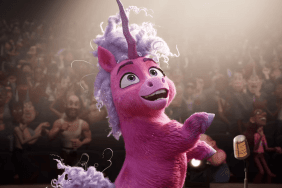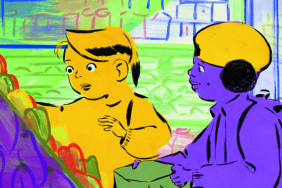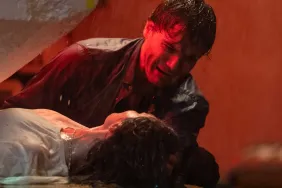On Christmas Day, two icons of cinematic boxing are set to go head to head when the bell sounds for director Peter Segal’s latest comedy, Grudge Match. Sylvester Stallone and Robert De Niro star as Henry “Razor” Sharp and Billy “The Kid” McDonnen, two former champions that have let decades stand between their last two bouts. With one victory each against the other, Sharp and McDonnen decide that, despite getting on in years, they’re going to settle things once and for all in the ring.
Segal, whose previous features include films like Get Smart, Anger Management, Tommy Boy and 50 First Dates, spoke with ComingSoon.net about Grudge Match‘s ambitious team-up and what it really took to make the Stallone / De Niro team-up a reality. (Segal, as he explains below, even went so far as to enlist the help of Martin Scorsese for one sequence that makes use of movie magic to show younger versions of the stars facing off.
Also covered in the below conversation are Segal’s thoughts on returning for a Get Smart sequel, his upcoming Jonny Quest and his now on-indefinite-hold plans for a big screen take on a DC Comics superhero, Billy Batson and the Legend of Shazam.
CS: How do you go about balancing these new, original characters with the iconic boxing roles we know the actors from?
Peter Segal: At first, I got Bob [De Niro template=’galleryview’]–> to commit to the movie. Sly [Stallone template=’galleryview’]–> was a little more difficult because he had not done what Bob had, which is wink at his earlier work. Bob, for example, had “Analyze This” towards “The Godfather.” One of the ways I convinced Sly to do this was by showing him that we were trying to tell a different kind of story with a lighter tone, but that we weren’t doing parody. As we got into it, though, this one joke idea came up about drinking raw eggs. I thought, “Well, okay. There’s one wink directly at ‘Rocky I,'” but I wasn’t sure how Sly would respond to that. I had been telling him very clearly that this was not a spoof and it’s not a spoof, but he liked that joke so much he said, “Actually, I think you should come up with bookends and at least one more so that it doesn’t just sit out there as an errant link that doesn’t have a companion. Then we came up with a meat locker bit and that’s where we stopped. We didn’t put any more in, because we didn’t want to distract with nods. There might be one or two more smaller, subtler references, but we are in the world of comedy-slash-drama, not parody.
CS: As interesting as De Niro and Stallone are together, the comedy pairing that sort of steals the show is Alan Arkin and Kevin Hart. What was it like bringing those two together for the first time?
Segal: Oh yeah. Those guys are hilarious. I went after Alan Arkin early. I had worked with him before and just adored him. Originally, though, the Dante Slate role was written for an older man. When the cast started to come together and crystalize, I realized maybe we should mix it up a little bit and inject a little youth into the cast. We went after Kevin Hart and rewrote the role to be the disgruntled son of the former promoter that not only swindled Bob and Sly out of their winnings, but also left this bad legacy for his son. That was the backstory and we threw Kevin in the ring with Alan and created a new comedy team.

CS: “Grudge Match” is very much a family film. It’s hitting at Christmas and it seems like, while Christmas isn’t really a plot element, the holiday season is definitely in the background. Was that always a plan in realizing the story?
Segal: The movie was originally supposed to be released in November, so I had the opportunity to write the season into it because we were filming in New Orleans almost a year ago exactly. It was a rare opportunity to have the season reflect the mood of the film. Because it’s set in Pittsburgh and is very much a Pittsburgh film, the cold weather also gives a look and feel to the film that makes it seem even more Christmasy, so we went for it.
CS: Is it fair to say that the projects you tend to gravitate towards are ones that combine comedy with verisimilitude?
Segal: Well, I read scripts and I try to position myself as Joe Popcorn. Would I go see that movie? I don’t read them analytically at first. If they appeal to me as just entertaining or engaging or funny or whatever the genre is, I take that for what it is. Then I go back and analyze, asking, “What could I do with this?” First and foremost, though, I just look and see if I feel like it’s going to be an interesting and entertaining and engaging story.
CS: What was it like bringing De Niro and Stallone together for the first time during pre-production?
Segal: Well, it was dream-casting that no one really thought we’d be able to pull off. That was the scary part about it. I had spent a year already working on this script and I realized, “Oh my god. What have I done? If we don’t get this perfect casting, this has been a complete waste of time.” It would be like trying to recast “Being John Malkovich” with someone else. So the challenge was bringing them together and, by the time we did, that was movie magic. I forgot who I was the first time those guys stepped foot in the ring together to rehearse. I just pulled out my cell phone and became a kid taking pictures.
CS: How immersed do you get yourself in these cinematic icons? Do you sit down and watch every “Rocky” movie?
Segal: I do. I want to know what to stay away from. First of all, I love the “Rocky” franchise. I have watched it and “Raging Bull” a million times to the point that, when I asked my 13-year-old son what he thought about the concept of this movie, he said it was really cool. I said, “How do you know ‘Raging Bull’?” He said, “Because, Dad, you watch it all the time and I’ve watched it over your shoulder.” But I wanted to make sure I understood the whole boxing world because, obviously, there is going to be some repetition, as there is in romantic comedies. Boy meets girl, boy loses girl, boy gets girl back again. Someone is going to get knocked down to the canvas and we’re going to wonder if they’re going to be able to pull themselves back up again. Within that confine, I wanted to be as original as I could and tell a unique story with a different kind of tone that people haven’t seen before. I wanted to straddle humor with the drama and action of a real fight.
CS: At the very beginning of the film, there’s a sequence with a young De Niro and a young Stallone. How tricky was it to shoot that and what went into the special effects?
Segal: That was pretty difficult. We worked with the same company that did the de-aging on Brad Pitt in “The Curious Case of Benjamin Button.” No one had taken the aging to this extent. They had taken off 15 years or 20 years, but not 30. It doesn’t sound like a big difference, but it is. For those early scenes, we put Bob and Sly in these weird machines that have a thousand lights that circle completely around them. We had a million different cameras. It would photograph their faces doing the action of those early flashback fights. Then they would meticulously de-age them and track those faces onto younger bodies. Ironically, Jon Bernthal, who plays De Niro’s son, also played the younger De Niro’s body in flashbacks. That was some of the tricks we used, but I also contacted Martin Scorsese and John Avildsen and we got permission to use rehearsal footage from “Rocky” and from “Raging Bull.” It was a combination of never-before-seen footage and a never-before-used technique to put that opening montage together.
CS: What was it like explaining this project to Martin Scorsese?
Segal: I got to meet him and thank him for giving us the footage at Bob’s birthday party, so that was a thrill. I told him that he’s finally going to be credited as a cinematographer and he laughed. I saw an interview with Thelma Schoonmaker talking about how Scorsese photographed the rehearsals. I was having a really tough time trying to find footage to begin with of Bob in his early days, especially doing anything boxing related. I couldn’t take clips from the movie because it was shot in black and white and his hair was a different style and he had makeup. It was incredibly fortuitous to find out that this footage existed, so I asked Bob if he wouldn’t mind asking Scorsese if the footage still existed. Of course, he’s one of the great film preservationists, so it did. He shot it on 16mm. He gave me this footage, which was spectacular, which was De Niro sparring with Jake LaMotta with a beer gut and blue jeans. It was like opening a treasure chest and looking inside.

CS: It seems like what you went through is, in many ways, a real world version of the events of the film wherein a lot of preparation goes into staging this iconic match.
Segal: Yeah, there’s an interesting subtext with the weight of Jake LaMotta and Rocky Balboa just beneath the surface. That was a cool idea, but the challenge was then getting the audience to forget that these actors are anything but those characters. I was so gratified when, after the first test screening, I found out that the audience was calling them by their character names, “Razor” Sharp and “Kid” McDonnen and not by their alter egos from their other movies. That was a big, big question for me as to whether or not we could pull it off. It’s almost like if you saw Robert Downey Jr. play a different superhero. Would you accept that, or would you always think of him just as Iron Man?
CS: Speaking of superheroes, you were developing a DC Comics property a few years and a film was being planned called “Billy Batson and the Legend of Shazam.” Whatever happened to that?
Segal: The thing is, Shazam has always lived this tortured life going against Superman. This dates back to the 1930s. Because Captain Marvel had similar powers to Superman, the DC folks back then sued what was the most popular comic book on the stands at that time. Years later, they bought it and it became a DC property but, as long as Superman stays hot in the market place, there seems like a little bit of a crossover between the two characters. After Bryan Singer’s “Superman Returns,” it seemed like there was a moment in time where Shazam was going to see the light of day. That’s when you heard those stories. Now that Superman is being invigorated and going up against Batman, I think it’s difficult for DC to figure out how to launch this character in the wake of Superman’s resurgence.
CS: It sounded like your approach was a bit more kid-friendly.
Segal: Well, it wasn’t. I was working with Geoff Johns. At its core, it’s a lot like Superman. There’s this boy trapped inside of a superhero’s body. He’s still a boy inside, so there’s this opportunity to play a lot of humor with the action. Originally, Stan Lee brought me “Fantastic Four” a number of years for that very reason. I always have the question when people bring me superhero properties, “Why me?” With Stan, he said, “It’s because there’s a sense of humor within all Marvel characters.” These characters are flawed and, within those flaws, there is humor. When Toby Emmerich came to me with Shazam, it was because of those same reasons. To draw from that humor and to mix it with great action and pathos. I’ve always loved Shazam, but I don’t know if it’s going to see the light of day anytime soon.
CS: What about a sequel to “Get Smart”? Is that something you’d be interested in tackling?
Segal: I would love to see a sequel to “Get Smart,” and, if anything, “Anchorman 2” just shows that nine years is not too long. So maybe one day there will be.
CS: Do you know what is going to be next for you?
Segal: Yeah, we’re working on a live-action version of “Jonny Quest” at Warner Bros. We’re hoping that’s next up. We just hired a writer to do another pass. We already have a very good script. Then we go through budgeting hell and trying to get it into shape. I would love to make that my next movie.
Grudge Match hits theaters December 25.
Grudge Match
-
Grudge Match

-
Grudge Match

-
Grudge Match

-
Grudge Match

-
Grudge Match

-
Grudge Match

-
Grudge Match

-
Grudge Match

-
Grudge Match

-
Grudge Match

-
Grudge Match

-
Grudge Match

-
Grudge Match

-
Grudge Match

-
Grudge Match

-
Grudge Match

-
Grudge Match

-
Grudge Match

-
Grudge Match

-
Grudge Match

-
Grudge Match

-
Grudge Match

-
Grudge Match

-
Grudge Match

-
Grudge Match

-
Grudge Match

-
Grudge Match

-
Grudge Match

-
Grudge Match

-
Grudge Match

-
Grudge Match

-
Grudge Match

-
Grudge Match

-
Grudge Match

-
Grudge Match

-
Grudge Match

-
Grudge Match

-
Grudge Match

-
Grudge Match










